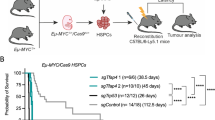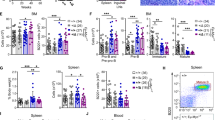Abstract
Oct-1 and Oct-2 are members of the POU homeodomain family of transcriptional regulators and are critical for normal embryonic development. Gene-targeting studies showed that Oct-1 and Oct-2 are largely dispensable for B-cell development and immunoglobulin production, although both Oct-2 and Bob-1 are required for a proper immune response and germinal center formation. In these studies, we investigated the role of Oct factors in B-cell lymphomas. Recent investigations have shown increased expression of Oct-2 and Bob-1 in lymphomas, and we observed greatly increased levels of Oct-2 in lymphoma cells with the t(14;18) translocation. Decreased expression of Oct-1, Oct-2, or Bob-1 by RNA interference resulted in apoptosis and down-regulation of bcl-2 expression. Furthermore, Oct-2 induced bcl-2 promoter activity and mediated this effect through three regions in the bcl-2 P2 promoter. Although these regions did not contain canonical octamer motifs, we observed the direct interaction of Oct-2 with all three sites both in vitro by EMSA and in vivo by chromatin immunoprecipitation assay. Moreover, by mutation analysis we found that the ability of Oct-2 to activate bcl-2 required C/EBP, Cdx, and TATA-binding sites. Oct-2, therefore, acts as a cell survival factor in t(14;18) lymphoma cells by directly activating the antiapoptotic gene bcl-2.
This is a preview of subscription content, access via your institution
Access options
Subscribe to this journal
Receive 50 print issues and online access
$259.00 per year
only $5.18 per issue
Buy this article
- Purchase on Springer Link
- Instant access to full article PDF
Prices may be subject to local taxes which are calculated during checkout








Similar content being viewed by others
References
Annweiler A, Zwilling S, Wirth T . (1994). Nucl Acids Res 22: 4250–4258.
Bendall HH, Scherer DC, Edson CR, Ballard DW, Oltz EM . (1997). J Biol Chem 272: 28826–28828.
Bertolino E, Singh H . (2002). Mol Cell 10: 397–407.
Brunner C, Marinkovic D, Klein J, Samardzic T, Nitschke L, Wirth T . (2003). J Exp Med 197: 1205–1211.
Chen H-M, Boxer LM . (1995). Mol Cell Biol 15: 3840–3847.
Corcoran LM, Karvelas M, Nossal GJ, Ye ZS, Jacks T, Baltimore D . (1993). Genes Dev 7: 570–582.
Dunn TL, Ross IL, Hume DA . (1996). Blood 88: 4072–4073.
Frampton J, Ramqvist T, Graf T . (1996). Genes Dev 10: 2720–2731.
Grassilli E, Salomoni P, Perrotti D, Franceschi C, Calabretta B . (1999). Cancer Res 59: 2451–2456.
Greiner A, Muller KB, Hess J, Pfeffer K, Muller-Hermelink HK, Wirth T . (2000). Am J Pathol 150: 501–507.
Grenfell SJ, Latchman DS, Thomas NS . (1996). Biochem J 315: 889–893.
Hatada EN, Chen-Kiang S, Scheidereit C . (2000). Eur J Immunol 30: 174–184.
He X, Treacy MN, Simmons DM, Ingraham HA, Swanson LW, Rosenfeld MG . (1989). Nature 340: 35–41.
Heckman C, Mochon E, Arcinas M, Boxer LM . (1997). J Biol Chem 272: 19609–19614.
Heckman CA, Cao T, Somsouk L, Duan H, Mehew JW, Zhang C et al. (2003a). Cancer Res 63: 6666–6673.
Heckman CA, Mehew JW, Boxer LM . (2002). Oncogene 21: 3898–3908.
Heckman CA, Mehew JW, Ying G-G, Introna M, Golay J, Boxer LM . (2000). J Biol Chem 275: 6499–6508.
Heckman CA, Wheeler MA, Boxer LM . (2003b). Oncogene 22: 7891–7899.
Hoefnagel JJ, Dijkman R, Basso K, Jansen PM, Hallermann C, Willemze R et al. (2005). Blood 105: 3671–3678.
Husson H, Carideo EG, Neuberg D, Schultze J, Munoz O, Marks PW et al. (2002). Blood 99: 282–289.
Inamoto S, Segil N, Pan ZQ, Kimura M, Roeder RG . (1997). J Biol Chem 272: 29852–29858.
Ji L, Mochon E, Arcinas M, Boxer LM . (1996). J Biol Chem 271: 22687–22691.
Jin T, Li H . (2001). J Biol Chem 276: 14752–14758.
Kang SM, Tsang W, Doll S, Scherle P, Ko HS, Tran AC et al. (1992). Mol Cell Biol 12: 3149–3154.
Kim U, Qin XF, Gong S, Stevens S, Luo Y, Nussenzweig M et al. (1996). Nature 383: 542–547.
Kim U, Siegel R, Ren X, Gunther CS, Gaasterland T, Roeder RG . (2003). Proc Natl Acad Sci USA 100: 8868–8873.
LeBowitz JH, Clerc RG, Brenowitz M, Sharp PA . (1989). Genes Dev 3: 1625–1638.
Lossos IS, Levy R . (2000). Blood 96: 635–639.
Marafioti T, Ascani S, Pulford K, Sabattini E, Piccioli M, Jones M et al. (2003). Am J Pathol 162: 861–871.
McDonnell TJ, Korsmeyer SJ . (1991). Nature 349: 254–256.
Meeker T, Lowder J, Maloney DG, Miller R, Thielemans K, Warnke R et al. (1985). Blood 65: 1349–1354.
Miller CL, Feldhaus AL, Rooney JW, Rhodes LD, Sibley CH, Singh H . (1991). Mol Cell Biol 11: 4885–4894.
Nagy M, Chapuis B, Matthes T . (2002). Br J Haematol 116: 429–435.
Nielsen PJ, Georgiev O, Lorenz B, Schaffner W . (1996). Eur J Immunol 26: 3214–3218.
Pileri SA, Gaidano G, Zinzani PL, Falini B, Gaulard P, Zucca E et al. (2003a). Am J Pathol 162: 243–253.
Pileri SA, Zinzani PL, Gaidano G, Falini B, Gaulard P, Zucca E et al. (2003b). Leuk Lymphoma 44: S21–S26.
Poellinger L, Roeder RG . (1989). Mol Cell Biol 9: 747–756.
Robetorye RS, Bohling SD, Morgan JW, Fillmore GC, Lim MS, Elenitoba-Johnson KS . (2002). J Mol Diagn 4: 123–136.
Romero F, Martinez AC, Camonis J, Rebollo A . (1999). EMBO J 18: 3419–3430.
Sauter P, Matthias P . (1997). Immunobiology 198: 207–216.
Schubart DB, Rolink A, Kosco-Vilbois MH, Botteri F, Matthias P . (1996). Nature 383: 538–542.
Schubart K, Massa S, Schubart D, Corcoran LM, Rolink AG, Matthias P . (2001). Nat Immunol 2: 69–74.
Sepulveda MA, Emelyanov AV, Birshtein BK . (2004). J Immunol 172: 1054–1064.
Seto M, Jaeger U, Hockett RD, Graninger W, Bennett S, Goldman P et al. (1988). EMBO J 7: 123–131.
Staudt LM, Clerc RG, Singh H, LeBowitz JH, Sharp PA, Baltimore D . (1988). Science 241: 577–580.
Tanaka M, Herr W . (1990). Cell 60: 375–386.
Taylor D, Badiani P, Weston K . (1996). Genes Dev 10: 2732–2744.
Wang VE, Schmidt T, Chen J, Sharp PA, Tantin D . (2004). Mol Cell Biol 24: 1022–1032.
Wilson BE, Mochon E, Boxer LM . (1996). Mol Cell Biol 16: 5546–5556.
Wirth T, Priess A, Annweiler A, Zwilling S, Oeler B . (1991). Nucl Acids Res 19: 43–51.
Wong MW, Henry RW, Ma B, Kobayashi R, Klages N, Matthias P et al. (1998). Mol Cell Biol 18: 368–377.
Wu Y, Mehew JW, Heckman CA, Arcinas M, Boxer LM . (2001). Oncogene 20: 240–251.
Zwilling S, Dieckmann A, Pfisterer P, Angel P, Wirth T . (1997). Science 277: 193–194.
Acknowledgements
We gratefully acknowledge the assistance of Lusijah Rott and Cathy Crumpton of the Stanford University Digestive Disease Center Flow Cytometry Facility. We thank Minh Ho and John Mehew for technical assistance. The Oct-1 and Oct-2 expression vectors were kindly provided by Dr Daniel Tenen through Dr Masahiko Tanaka. Dr Winship Herr generously provided the Bob-1 expression vector. The DHL-6 cells were provided to us by Dr Ronald Levy. This work was supported by the National Institutes of Health Grant CA56764.
Author information
Authors and Affiliations
Corresponding author
Rights and permissions
About this article
Cite this article
Heckman, C., Duan, H., Garcia, P. et al. Oct transcription factors mediate t(14;18) lymphoma cell survival by directly regulating bcl-2 expression. Oncogene 25, 888–898 (2006). https://doi.org/10.1038/sj.onc.1209127
Received:
Revised:
Accepted:
Published:
Issue Date:
DOI: https://doi.org/10.1038/sj.onc.1209127
Keywords
This article is cited by
-
Overexpression of OCT-1 gene is a biomarker of adverse prognosis for diffuse large B-cell lymphoma (DLBCL): data from a retrospective cohort of 77 Brazilian patients
BMC Cancer (2020)
-
Genome-wide analyses of long noncoding RNA expression profiles in lung adenocarcinoma
Scientific Reports (2017)
-
Inter- and intratumoral heterogeneity of BCL2 correlates with IgH expression and prognosis in follicular lymphoma
Blood Cancer Journal (2014)
-
Oct-2 Transcription Factor Binding Activity and Expression Up-Regulation in Rat Cerebral Ischaemia is Associated with a Diminution of Neuronal Damage In Vitro
NeuroMolecular Medicine (2014)
-
Functional long-range interactions of the IgH 3′ enhancers with the bcl-2 promoter region in t(14;18) lymphoma cells
Oncogene (2008)



